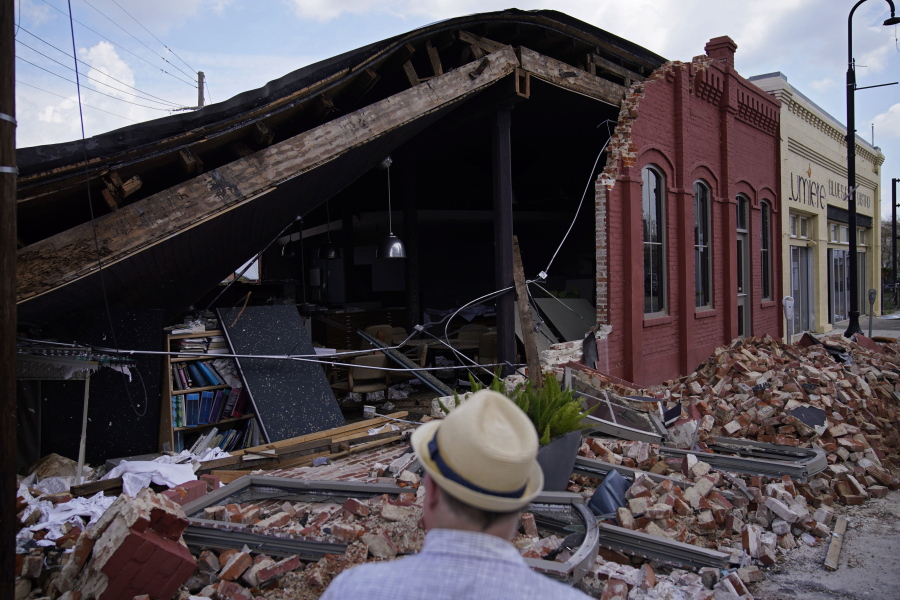HOUMA, La. — Full restoration of electricity to some of the hardest-hit areas of Louisiana battered to an unprecedented degree by Hurricane Ida could take until the end of the month, the head of Entergy Louisiana warned Saturday.
At least 16 deaths were blamed on the storm in Louisiana, Mississippi and Alabama.
Ida damaged or destroyed more than 22,000 power poles, more than hurricanes Katrina, Zeta and Delta combined, an impact that Entergy President and CEO Phillip May called “staggering.” More than 5,200 transformers failed, and nearly 26,000 spans of wire — the stretch of transmission wires between poles — were down.
“The level of devastation makes it quite difficult or near impossible to get in and fully assess some places,” May said of five southeastern Louisiana parishes facing the longest delays. The company is estimating full power restoration by Sept. 29 or even longer for some customers.
About a quarter of New Orleans residents have power back, including all the city’s hospitals, and the city’s 27 substations are ready to serve customers, said Deanna Rodriguez, Entergy New Orleans president and CEO. Most customers should have power back by Wednesday, Entergy said.
One of the parishes facing long delays for power restoration is Terrebonne, where volunteers in the parish seat of Houma handed out ice, water and meals to shell-shocked storm survivors Saturday. Houma is roughly 55 miles southwest of New Orleans.
Among those in need was 26-year-old Kendall Duthu of Dulac, who collected a container of red beans and rice, pulling over an Infiniti with a shattered windshield to eat.
Duthu has been living in his car, with his girlfriend, since the storm hit. He was a cook at a jambalaya restaurant before the pandemic claimed that job, then a car wash worker until that went away. Duthu, a diabetic, lost his house in the storm and doesn’t know what’s next.
“Next stop, I don’t really …” he said, trailing off. “We’ve just been living day by day.”
Houma’s Hancock Whitney Bank, itself badly damaged by Ida, has distributed water along with about 42,000 meals since Tuesday, said CEO John Hairston.
“Hurricanes are just a part of life,” he said. “Buildings come and go. We may be on a different block. But next storm, we’ll be here.”
South of Houma, splintered trees, swamped furniture and the wreckage of houses littered roadsides. In Ashland, La., 27-year-old Rene Gregoire Jr. stood outside his house, where windows blew out and water gushed in. It was the latest blow for the tugboat worker after badly hurting his wrist on the job, contracting COVID-19, and his dog requiring a $3,000 surgery.
“It’s my home, but I gotta find something new,” Gregoire said, pondering a move to Arizona with his girlfriend.
Just south along Bayou Grand Caillou, Harry Bonvillain surveyed damage to his home, a house raised on concrete pillars now surrounded by a maze of broken staircases and splintered lumber.
Many of Bonvillain’s possessions were lost, mildew covered his clothes, and ants were taking over the house. With so much attention on New Orleans, the 58-year-old Bonvillain wondered why more people didn’t care about smaller communities like his.
He described himself as “sick. Tired. Stressed out. Depressed. Anxiety high.”
Some parishes outside New Orleans were battered for hours by winds of 100 mph or more.
By Saturday morning, 97 percent of damage assessment was complete and power was restored to about 282,000 customers from the peak of 902,000 blacked out after Ida.
The lower Mississippi River reopened to all vessel traffic in New Orleans and ports throughout southeastern Louisiana after power lines from a downed transmission tower were removed, the Coast Guard said.



